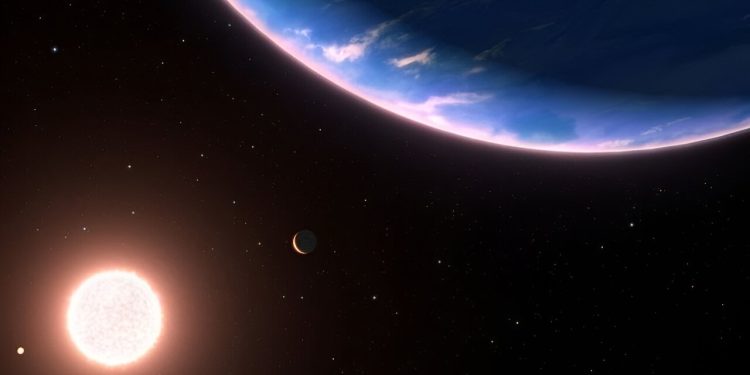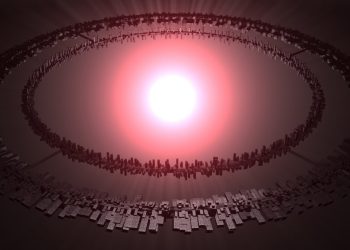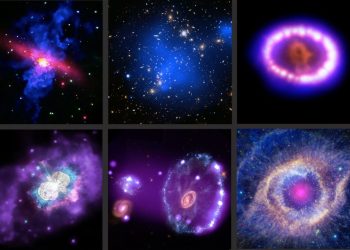An international team of astronomers has made a groundbreaking discovery about a distant exoplanet, GJ 9827 d, located approximately 98 light-years away in the constellation Pisces. Using the James Webb Space Telescope (JWST), scientists uncovered critical details about the planet’s atmosphere, which is rich in water vapor and heavier molecules, positioning it as a potential “steam world.”
Unveiling a ‘Steam World’
Led by Caroline Piaulet-Ghorayeb, a Ph.D. candidate at the Université de Montréal’s Trottier Institute for Research on Exoplanets (IREx), the study presents compelling evidence of a unique planetary atmosphere. Unlike the hydrogen-dominated atmospheres typically found on gas giants, GJ 9827 d’s atmosphere is filled with heavier molecules, including significant amounts of water vapor. This groundbreaking discovery suggests that the planet could be what astronomers call a “steam world.”
Published in The Astrophysical Journal Letters, the study builds on previous research using the Hubble Space Telescope (HST), which detected water in GJ 9827 d’s atmosphere. This makes it one of the smallest exoplanets, at just twice the size of Earth, to have a confirmed atmosphere.
Shifting Focus to Smaller Planets
For years, the hunt for exoplanet atmospheres has centered around massive gas giants or mini-Neptunes, planets many times larger than Earth with atmospheres dominated by hydrogen. These worlds, like Jupiter and Neptune in our solar system, are fascinating, but far from ideal candidates in the search for habitable conditions.
Smaller planets like GJ 9827 d, however, are much closer to Earth’s size and offer a more promising avenue for research. Detecting atmospheres around such small planets has been a major challenge until now. The discovery of a water-rich atmosphere on GJ 9827 d marks a pivotal step forward.
“Until now, all detected atmospheres belonged to large planets, mostly dominated by hydrogen,” said Piaulet-Ghorayeb. “GJ 9827 d is unique because its atmosphere contains a significant amount of heavier molecules, which aligns it more closely with terrestrial planets like Earth.”
A Water-Rich Atmosphere
What sets GJ 9827 d apart from larger exoplanets is the composition of its atmosphere. By analyzing data from JWST and HST, researchers confirmed that GJ 9827 d’s atmosphere contains a dense concentration of water vapor and other heavy molecules, diverging sharply from the hydrogen-rich atmospheres typically found on gas giants.
This marks the first time scientists have observed an exoplanet where hydrogen is not the dominant atmospheric component. The findings open new pathways for studying atmospheres on small, rocky planets and may bring scientists closer to discovering planets that could support life.
Using the Near-Infrared Imager and Slitless Spectrograph (NIRISS) on JWST, the research team analyzed starlight as it passed through the planet’s atmosphere during transit, allowing them to identify the unique spectral signatures of water and other molecules. These findings were further corroborated with data from HST, ensuring the signals were not distorted by the planet’s host star.
The team’s analysis suggests that GJ 9827 d’s atmosphere may be a superheated mixture of gases, possibly without distinct layers or clouds, due to its proximity to its host star.
A Step Closer to Finding Habitable Planets
Though GJ 9827 d itself is unlikely to be habitable—it orbits too close to its star, resulting in surface temperatures exceeding 350°C—the discovery of a water-rich atmosphere on such a small planet is a major leap forward. It serves as a proof of concept that atmospheres rich in heavy molecules can exist on smaller planets, providing essential data for the search for habitable environments.
“This is a critical step toward finding atmospheres on planets similar to Earth,” said Piaulet-Ghorayeb. “GJ 9827 d is the first exoplanet where we’ve detected an atmosphere rich in heavy molecules like those found in the terrestrial planets of our solar system.”
Further JWST observations of GJ 9827 d are planned, which could reveal even more details about its atmospheric composition, giving scientists deeper insights into its structure and properties.











